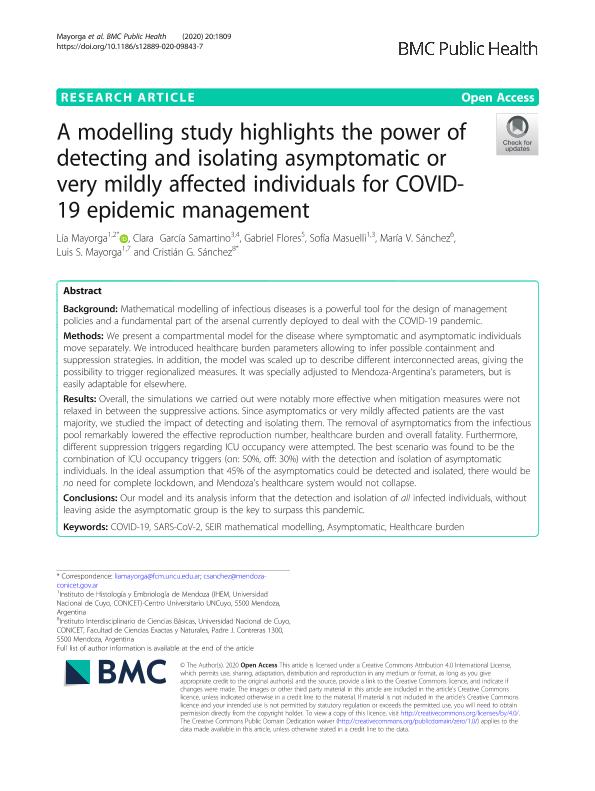Mostrar el registro sencillo del ítem
dc.contributor.author
Mayorga, Lía

dc.contributor.author
García Samartino, Clara
dc.contributor.author
Flores, Gabriel
dc.contributor.author
Masuelli, Sofía

dc.contributor.author
Sanchez Sanchez, Maria Victoria

dc.contributor.author
Mayorga, Luis Segundo

dc.contributor.author
Sánchez, Cristián G.
dc.date.available
2020-12-15T17:33:50Z
dc.date.issued
2020-12
dc.identifier.citation
Mayorga, Lía; García Samartino, Clara; Flores, Gabriel; Masuelli, Sofía; Sanchez Sanchez, Maria Victoria; et al.; A modelling study highlights the power of detecting and isolating asymptomatic or very mildly affected individuals for COVID-19 epidemic management; BioMed Central; BMC Public Health; 20; 1; 12-2020; 1-11
dc.identifier.issn
1471-2458
dc.identifier.uri
http://hdl.handle.net/11336/120477
dc.description.abstract
Background: Mathematical modelling of infectious diseases is a powerful tool for the design of management policies and a fundamental part of the arsenal currently deployed to deal with the COVID-19 pandemic. Methods: We present a compartmental model for the disease where symptomatic and asymptomatic individuals move separately. We introduced healthcare burden parameters allowing to infer possible containment and suppression strategies. In addition, the model was scaled up to describe different interconnected areas, giving the possibility to trigger regionalized measures. It was specially adjusted to Mendoza-Argentina’s parameters, but is easily adaptable for elsewhere. Results: Overall, the simulations we carried out were notably more effective when mitigation measures were not relaxed in between the suppressive actions. Since asymptomatics or very mildly affected patients are the vast majority, we studied the impact of detecting and isolating them. The removal of asymptomatics from the infectious pool remarkably lowered the effective reproduction number, healthcare burden and overall fatality. Furthermore, different suppression triggers regarding ICU occupancy were attempted. The best scenario was found to be the combination of ICU occupancy triggers (on: 50%, off: 30%) with the detection and isolation of asymptomatic individuals. In the ideal assumption that 45% of the asymptomatics could be detected and isolated, there would be no need for complete lockdown, and Mendoza’s healthcare system would not collapse. Conclusions: Our model and its analysis inform that the detection and isolation of all infected individuals, without leaving aside the asymptomatic group is the key to surpass this pandemic.
dc.format
application/pdf
dc.language.iso
eng
dc.publisher
BioMed Central

dc.rights
info:eu-repo/semantics/openAccess
dc.rights.uri
https://creativecommons.org/licenses/by/2.5/ar/
dc.subject
ASYMPTOMATIC
dc.subject
COVID-19
dc.subject
HEALTHCARE BURDEN
dc.subject
SARS-COV-2
dc.subject
SEIR MATHEMATICAL MODELLING
dc.subject.classification
Epidemiología

dc.subject.classification
Ciencias de la Salud

dc.subject.classification
CIENCIAS MÉDICAS Y DE LA SALUD

dc.title
A modelling study highlights the power of detecting and isolating asymptomatic or very mildly affected individuals for COVID-19 epidemic management
dc.type
info:eu-repo/semantics/article
dc.type
info:ar-repo/semantics/artículo
dc.type
info:eu-repo/semantics/publishedVersion
dc.date.updated
2020-12-15T14:58:50Z
dc.journal.volume
20
dc.journal.number
1
dc.journal.pagination
1-11
dc.journal.pais
Reino Unido

dc.journal.ciudad
Londres
dc.description.fil
Fil: Mayorga, Lía. Consejo Nacional de Investigaciones Científicas y Técnicas. Centro Científico Tecnológico Conicet - Mendoza. Instituto de Histología y Embriología de Mendoza Dr. Mario H. Burgos. Universidad Nacional de Cuyo. Facultad de Ciencias Médicas. Instituto de Histología y Embriología de Mendoza Dr. Mario H. Burgos; Argentina. Consejo Nacional de Investigaciones Científicas y Técnicas. Oficina de Coordinación Administrativa Ciudad Universitaria. Instituto de Química Biológica de la Facultad de Ciencias Exactas y Naturales. Universidad de Buenos Aires. Facultad de Ciencias Exactas y Naturales. Instituto de Química Biológica de la Facultad de Ciencias Exactas y Naturales; Argentina
dc.description.fil
Fil: García Samartino, Clara. Universidad Nacional de Cuyo. Facultad de Odontologia; Argentina
dc.description.fil
Fil: Flores, Gabriel. No especifíca;
dc.description.fil
Fil: Masuelli, Sofía. Consejo Nacional de Investigaciones Científicas y Técnicas. Centro Científico Tecnológico Conicet - Mendoza. Instituto de Histología y Embriología de Mendoza Dr. Mario H. Burgos. Universidad Nacional de Cuyo. Facultad de Ciencias Médicas. Instituto de Histología y Embriología de Mendoza Dr. Mario H. Burgos; Argentina
dc.description.fil
Fil: Sanchez Sanchez, Maria Victoria. Consejo Nacional de Investigaciones Científicas y Técnicas. Centro Científico Tecnológico Conicet - Mendoza. Instituto de Medicina y Biología Experimental de Cuyo; Argentina
dc.description.fil
Fil: Mayorga, Luis Segundo. Consejo Nacional de Investigaciones Científicas y Técnicas. Centro Científico Tecnológico Conicet - Mendoza. Instituto de Histología y Embriología de Mendoza Dr. Mario H. Burgos. Universidad Nacional de Cuyo. Facultad de Ciencias Médicas. Instituto de Histología y Embriología de Mendoza Dr. Mario H. Burgos; Argentina
dc.description.fil
Fil: Sánchez, Cristián G.. Consejo Nacional de Investigaciones Científicas y Técnicas. Centro Científico Tecnológico Conicet - Mendoza. Instituto Interdisciplinario de Ciencias Básicas. - Universidad Nacional de Cuyo. Instituto Interdisciplinario de Ciencias Básicas; Argentina
dc.journal.title
BMC Public Health

dc.relation.alternativeid
info:eu-repo/semantics/altIdentifier/url/https://bmcpublichealth.biomedcentral.com/articles/10.1186/s12889-020-09843-7
dc.relation.alternativeid
info:eu-repo/semantics/altIdentifier/doi/http://dx.doi.org/10.1186/s12889-020-09843-7
Archivos asociados
